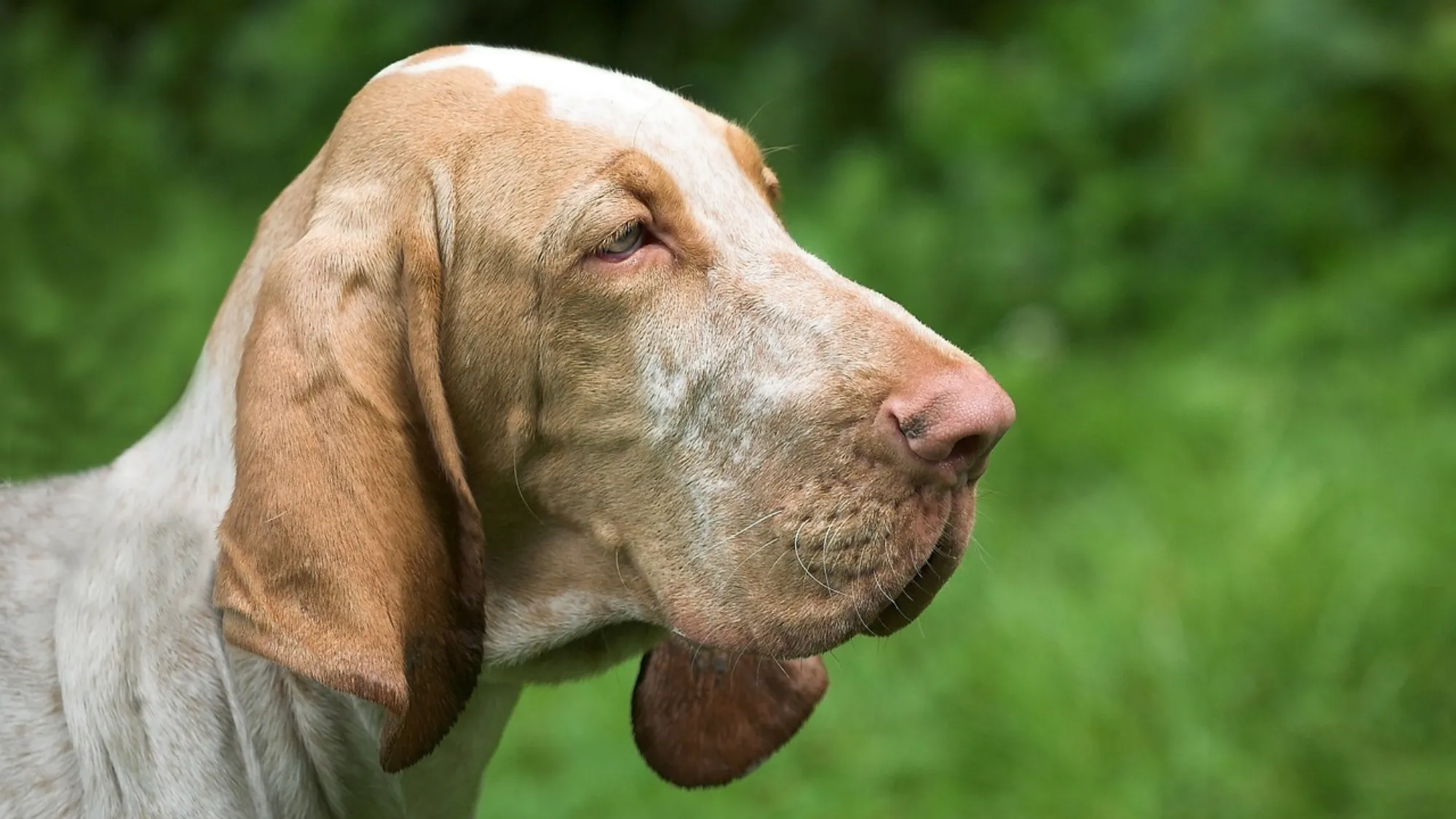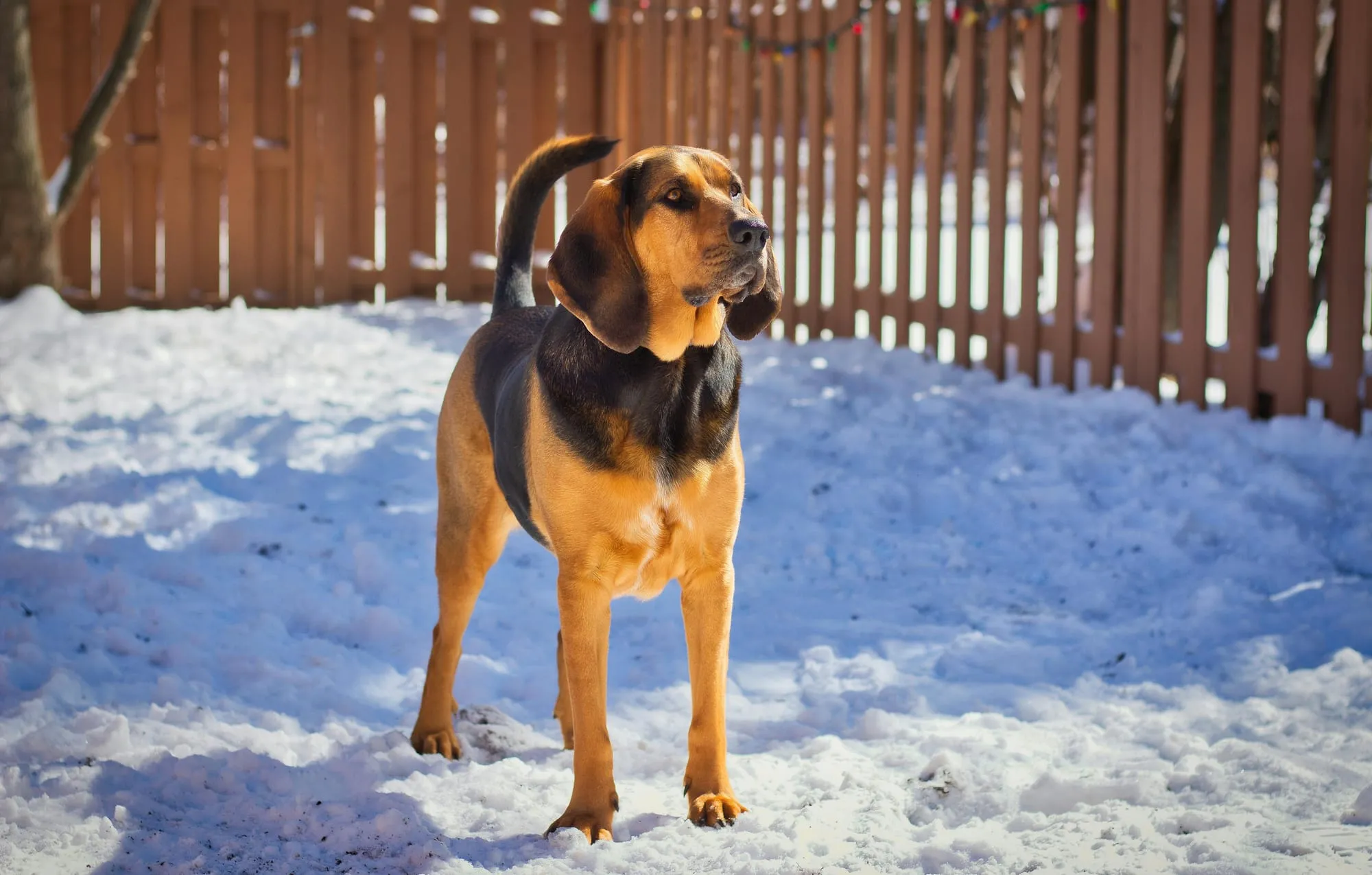Bloodhounds are a distinctive and venerable breed, renowned for their unparalleled sense of smell and tracking abilities. Originating from medieval Europe, they have a noble and storied history, often associated with tracking and law enforcement. Beyond their working capabilities, Bloodhounds possess a gentle and affectionate temperament, making them intriguing candidates as companion animals.
This article aims to explore the potential of Bloodhounds as household pets, delving into their unique characteristics, needs, and suitability for family life. It seeks to uncover the lesser-known aspects of Bloodhounds, highlighting their potential to be loving and loyal companions.

Understanding the Bloodhound Breed
The Bloodhound, a breed steeped in history, is renowned for its remarkable tracking abilities and distinctive appearance. Tracing its origins back to medieval Europe, the Bloodhound has a storied past. Initially bred by monks in Belgium, the breed was refined in England and France. Their name, often misconstrued as a reference to a 'bloody' purpose, actually derives from their status as 'blooded' hounds, indicating their pure and aristocratic lineage. Historically, Bloodhounds were utilized for tracking game and, more famously, for their unparalleled skill in human tracking, a role they still excel in today, especially in law enforcement.
Physically, Bloodhounds are imposing yet noble creatures. They are large dogs, with males typically weighing between 90 to 110 pounds and females slightly smaller. Their most striking features are their long, wrinkled faces and droopy ears, which enhance their scenting ability. Their deep-set eyes give them a solemn and thoughtful expression. Their coat is short, but dense, providing protection in various weather conditions, and comes in colors like black and tan, liver and tan, or red.
The temperament of the Bloodhound is as distinctive as its appearance. Despite their formidable size and history as tracking dogs, Bloodhounds are known for their gentle and patient nature. They are affectionate and friendly, often forming strong bonds with their families. This breed is known for its good-natured, even-tempered personality, making them excellent companions, particularly in homes with children. However, they can be somewhat independent and stubborn, traits that require consistent training from a young age. They also tend to be vocal, with a deep, resonant bark.
Their keen sense of smell and strong tracking instinct can sometimes lead them to wander if they catch an interesting scent. Thus, a secure living space is essential for a Bloodhound. Despite these few challenges, Bloodhounds are deeply loyal, affectionate, and thrive in a loving family environment, making them more than just skilled trackers — they are capable of being devoted and gentle companions.
Bloodhounds in a Family Setting
Exploring the dynamics of Bloodhounds within a family environment reveals their adaptability and affectionate nature. This section breaks down their suitability for families, interactions with children and other pets, and typical home behavior.
Family Suitability
- Gentle Giants: Despite their large size, Bloodhounds are known for their gentle and patient nature, making them well-suited for families.
- Adaptable Companions: They adapt well to family life, often becoming integral, affectionate members of the household.
Interactions with Children and Other Pets
- Children: Bloodhounds are generally good-natured and tolerant with children, often displaying a protective instinct.
- Other Pets: They typically coexist peacefully with other pets, especially when socialized early. However, supervision is advised due to their hunting background.
Behavior in a Home Environment
- Relaxed Indoors: In the home, Bloodhounds are usually calm and laid-back, enjoying relaxation time with family members.
- Space Requirements: They appreciate a spacious environment, preferably with a yard, but need secure fencing due to their tracking instincts.
- Vocal Nature: Known for their deep barking, Bloodhounds communicate vocally, which may require consideration in densely populated living areas.
- Grooming Needs: Regular grooming of their short coat and cleaning of their droopy eyes and ears is necessary for their well-being.
Bloodhounds, with their lovable and easygoing temperament, can seamlessly integrate into family life, bringing joy and companionship. Their presence in a home is marked by affection, loyalty, and a unique blend of tranquility and playfulness. The key to a harmonious life with a Bloodhound is understanding and accommodating their needs, ensuring they remain happy and healthy family members.
Training and Socialization
Training and socialization are pivotal in the development of a well-behaved and well-adjusted Bloodhound. This breed's characteristics pose unique challenges and opportunities in these areas.
Importance of Training and Socialization
- Early Learning: Early training and socialization are crucial for Bloodhounds. They are naturally curious and can be headstrong, making early, consistent training important to shape positive behaviors.
- Social Skills: Socialization helps Bloodhounds become comfortable with various environments, people, and other animals, reducing anxiety and potential aggression.
Challenges and Tips for Training Bloodhounds
Dealing with Stubbornness: Bloodhounds can be stubborn. Training requires patience, consistency, and positive reinforcement. Avoid harsh methods, as they respond best to rewards and praise.
- Harnessing Their Tracking Instinct: Use their natural scenting ability as part of training exercises. Games that involve tracking can be both mentally stimulating and a good learning experience.
- Keeping Them Engaged: Bloodhounds can get bored with repetitive tasks. Keep training sessions short, fun, and varied to maintain their interest.

Socialization Needs and Methods
- Early Exposure: Introduce your Bloodhound to a variety of settings, people, and animals early in life. Puppy classes can be a great way to start.
- Positive Experiences: Ensure each new experience is positive. Use treats and praise to associate new encounters with good outcomes.
- Regular Interaction: Regular walks in different environments, visits to dog-friendly spaces, and controlled meetings with other dogs and people can greatly enhance their social skills.
The key to successfully training and socializing a Bloodhound lies in understanding their unique temperament and harnessing their natural abilities. Patience, consistency, and a positive approach are essential in developing a well-mannered and sociable Bloodhound. With the right training and socialization, Bloodhounds can become well-rounded pets, capable of adapting to various environments and situations with ease and confidence.
Exercise and Activity Needs
Bloodhounds, with their robust build and high stamina, require adequate physical exercise to maintain their health and happiness. Understanding and meeting their exercise needs is key to a well-balanced lifestyle for these scent hounds.
Physical Exercise Requirements
- Daily Exercise: Bloodhounds need regular, moderate exercise to stay fit and healthy. Ideally, they should have at least one to two hours of exercise per day.
- Type of Exercise: Due to their tracking instincts, exercises that involve scent work are particularly beneficial and satisfying for them.
Suitable Activities for Bloodhounds
- Long Walks and Hikes: Bloodhounds enjoy long, leisurely walks or hikes, giving them the opportunity to explore different scents and environments.
- Scent Tracking Games: Engaging their natural tracking abilities, scent games or tracking exercises can be both mentally stimulating and physically rewarding for them.
- Playtime in a Secure Area: Given their propensity to follow a scent, a secure, fenced area is ideal for off-leash playtime.
Impact of Exercise on Their Health and Temperament
- Physical Health: Regular exercise helps prevent obesity, a common issue in the breed, and maintains cardiovascular health.
- Mental Health: Adequate physical activity is crucial for their mental well-being. It helps in reducing anxiety and stress, keeping them mentally stimulated.
- Behavioral Benefits: Exercise helps in managing potential behavioral issues. A well-exercised Bloodhound is less likely to engage in destructive behaviors caused by boredom or excess energy.
The exercise regimen for a Bloodhound should be carefully considered and incorporated into their daily routine. Activities that satisfy their scenting instincts while providing physical exertion are ideal. Regular exercise not only ensures their physical well-being but also aids in maintaining a calm and balanced temperament, making them delightful companions in both active and home settings.

Health and Maintenance
Bloodhounds, like any breed, have specific health concerns and maintenance needs. Understanding and addressing these can significantly enhance their quality of life.
Common Health Issues in Bloodhounds
- Ear Infections: Their long, floppy ears are prone to infections and require regular cleaning and monitoring.
- Bloat and Gastric Issues: As a deep-chested breed, Bloodhounds are susceptible to bloat, a life-threatening condition. Smaller, more frequent meals can help mitigate this risk.
- Hip and Elbow Dysplasia: This joint condition is common in larger breeds, and maintaining a healthy weight can help reduce the risk.
Grooming and Dietary Needs
- Coat Care: Bloodhounds have a short coat that needs regular brushing to remove loose hair and maintain skin health. They are moderate shedders.
- Bathing: Regular baths are important to keep their skin and coat clean, but over-bathing can strip natural oils, so balance is key.
- Dietary Management: A balanced diet suited to their age, size, and activity level is crucial. High-quality dog food that prevents obesity and provides all necessary nutrients is recommended.
Tips for Maintaining Their Overall Well-Being
- Regular Veterinary Check-ups: Routine vet visits are essential for early detection and management of any health issues.
- Exercise: Regular, moderate exercise is vital for maintaining a healthy weight and preventing joint issues.
- Mental Stimulation: Mental enrichment activities help keep them mentally sharp and prevent boredom-related behaviors.
- Dental Care: Regular dental check-ups and cleanings are important, as dental health is often overlooked in canines but is crucial to their overall health.
The health and maintenance of Bloodhounds require a proactive approach. Regular grooming, a well-managed diet, sufficient exercise, and routine veterinary care are key components in ensuring their long-term health and happiness. By attending to these needs, owners can help their Bloodhound companions lead a full, healthy, and contented life.
Bloodhounds as Working Dogs vs. Companions
Bloodhounds have a dual legacy as both esteemed working dogs and affectionate companions, each role highlighting different aspects of their character.
Bloodhounds in Working Roles
- Tracking and Law Enforcement: Bloodhounds are legendary for their tracking ability, used in law enforcement and search-and-rescue operations. Their extraordinary scenting capability allows them to follow trails over great distances and even after a significant time has elapsed.
- Specialized Training: Working Bloodhounds undergo rigorous training to hone their tracking skills, focusing on endurance, obedience, and scent discrimination.
Differences and Similarities in Needs
- Exercise Requirements: Both working and companion Bloodhounds require substantial exercise. However, the working dogs' regimen is more intensive, often involving specific training that simulates tracking scenarios.
- Mental Stimulation: The need for mental engagement is high in both roles. Working Bloodhounds satisfy this through their job, while companion dogs need alternative forms of mental exercise.
- Socialization and Training: Socialization and obedience training are crucial in both contexts. For working Bloodhounds, this training is more specialized, whereas companion Bloodhounds may focus more on basic household manners and social behaviors.
- Healthcare and Nutrition: Both require vigilant healthcare and a balanced diet. Working dogs might need a diet tailored to their higher energy expenditure.
In essence, whether serving as working dogs or as companions, Bloodhounds thrive on attention, structure, and activity. Their needs in terms of exercise, mental stimulation, and overall care are similar, with variations in intensity and focus based on their role. Regardless of their designation, Bloodhounds bring dedication and a unique set of skills to any environment they inhabit.

Conclusion
In summary, Bloodhounds, with their distinctive scenting abilities and gentle disposition, can make remarkable pets. They are well-suited for families seeking a loyal, affectionate companion, capable of adapting to various lifestyles. However, potential owners should be mindful of their specific needs, including regular exercise, consistent training, and dedicated grooming.
Embracing a Bloodhound as a pet means committing to their physical and emotional well-being, ensuring they lead a balanced and fulfilling life. For those willing to meet these needs, a Bloodhound offers unparalleled companionship, loyalty, and a unique, enriching presence in their lives.
FAQs
- What are the main characteristics of Bloodhounds?
- Bloodhounds are known for their exceptional tracking ability, gentle nature, and distinctive appearance with long, droopy ears and a wrinkled face. They are large, with a friendly and patient demeanor.
- How much exercise do Bloodhounds need?
- Bloodhounds require moderate exercise, typically one to two hours per day. Activities should ideally engage their scent-tracking abilities.
- Are Bloodhounds good with children?
- Yes, Bloodhounds are generally good with children, known for their gentle and tolerant nature. However, supervision is advised due to their size.
- Do Bloodhounds require a lot of grooming?
- Bloodhounds need regular grooming, including brushing, ear cleaning, and occasional baths to maintain their coat and overall health.
- Can Bloodhounds live in apartments?
- While Bloodhounds can adapt to apartment living, they thrive better in homes with more space and a secure yard, considering their size and exercise needs.
- Are Bloodhounds easy to train?
- Training a Bloodhound can be challenging due to their independent nature. Consistency, patience, and positive reinforcement techniques are recommended for best results.
- What health issues are common in Bloodhounds?
- Common health concerns in Bloodhounds include ear infections, bloat, and hip and elbow dysplasia. Regular veterinary check-ups and a healthy lifestyle can help manage these risks.
- Do Bloodhounds make good working dogs?
- Yes, Bloodhounds excel as working dogs, particularly in tracking and law enforcement roles, due to their unparalleled scenting abilities.




